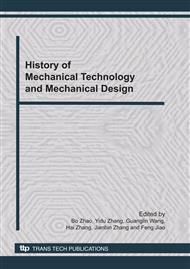[1]
N. De Geyter, R. Morent, C. Leys, L. Gengembre and E. Payen, Surf. Coat. Technol., Vol. 201 (2007), p.7066.
Google Scholar
[2]
D.J. Upadhyay and N.V. Bhat, Plasmas and Polymers, Vol. 8 (2003) No. 4, pp.237-257.
Google Scholar
[3]
Y. Liu, C.L. Deng, J. Zhao, J.S. Wang, L. Chen and Y.Z. Wang, Polym. Degrad. Stab. (2010), doi: 10. 1016/j. polymdegradstab. 2010. 02. 033.
Google Scholar
[4]
A.K. Mukherjee and B.D. Gupta, J. Appl. Polym. Sci., Vol. 30 (2003), p.2643.
Google Scholar
[5]
B. Gu, R. Chen, Y. Xu, X. Deng and Q.J. Shi: American Physical Society, 44th Annual Meeting of the Division of Plasma Physics. (Orando, USA: 2002).
Google Scholar
[6]
B. Gu, Y. Zhang, Y. Xu, R. Chen: 15th International Colloquium on Plasma Processes (Grenoble/Autrans, France: 2005).
Google Scholar
[7]
S.Y. Cheng, C.W.M. Yuen, C.W. Kan, K.K.L. Cheuk, W.A. Daoud, P.L. Lam and W.Y.I. Tsoi, Vacuum (2010), doi: 10. 1016/j. vacuum. 2010. 01. 012.
DOI: 10.1016/j.vacuum.2010.01.012
Google Scholar
[8]
Y. Zhang, B. Gu, W.C. Wang, D.Z. Wang and X.W. Peng, Spectrochim. Acta Part A: Molecular and Biomolecular Spectroscopy, Vol. 58 (2009), p.460.
Google Scholar
[9]
Z. Stefano, R. Claudia, G. Elisa, C. Claudia, M.V. Anna, N. Antonino, G.L. Pietro, L. Marina and M.D. Silvia, J. Colloid Interface Sci., Vol341 (2010), p.53.
Google Scholar
[10]
Y. Zhang, B. Gu, W.C. Wang, X.W. Peng and D.Z. Wang, Acta Phys. Sin., Vol. 58 (2009), p.5532.
Google Scholar
[11]
A. Ceria, G. Rovero, S. Sicardi and F. Ferrero, Chem. Eng. Process., Vol. 49 (2010), p.65.
Google Scholar
[12]
S. Kanazawa, M. Kogoma and S. Okazaki and T. Moriwaki, Nucl. Instrum. Methods Phys. Res., Vol. B37/38 (1989), pp.842-845.
Google Scholar
[13]
P.P. Tsai, L.C. Wadsworth and J.R. Roth, Text Res. J., Vol. 67 (1997) No. 5, pp.359-369.
Google Scholar
[14]
M. Šíra , D. Trunec , P. St'ahel , V. Buršíková, Z. Navrátil and J. Buršík, J Phys. D: Appl. Phys., Vol. 38 (2005) No. 4, pp.621-627.
DOI: 10.1088/0022-3727/38/4/015
Google Scholar


